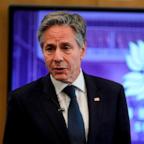Political Campaigns Through Photos
Oct. 26, 2006 — -- Over a period of more than 30 years, I covered presidential campaigns and the White House. Regardless of how well planned and well intentioned the people who undertake to lead the nation, their success or failure are often determined by photo ops.
On election eve in 1968, I witnessed a remarkable sight. Republican presidential candidate Richard Nixon had just touched down at an airbase in Orange County, Calif. The sun had set in the western sky, and as Nixon emerged from the United charter to come home to vote, the sound of massed bands filled the air, playing "Ruffles and Flourishes."
From a stadium at the edge of the tarmac, hundreds of cheerleaders formed an aisle to the bottom of the ramp at planeside. They all held flaming torches, leading to the entrance to the stadium that had been built for the event. Nixon walked down the corridor to a stage, where none other than John Wayne was waiting to greet him for his last rally of the campaign.
This spectacle was the brainchild of a senior Nixon advance man, Tim Elbourne.
Several weeks earlier I had entertained him at my apartment in New York during a campaign stop. I had a 16mm print of Leni Riefenstahl's famous documentary, "Triumph of the Will," which had been filmed during the Nazi Party rally in Nuremberg in 1934 that consolidated Adolph Hitler's rise to power. As I turned off the projector, I saw a weird light appear in Elbourne's eyes.
As we were landing in Orange County he told me, "You're about to get a big surprise."
Elbourne was the master of the photo op. Each day he would scan the front pages of newspapers to see how they were playing pictures of Nixon on campaign.
Although Nixon's campaign manager Herb Klein prided himself on how many minutes the candidate got on the evening newscasts, Elbourne on the other hand would define success simply by looking at the front page of The New York Daily News.
It was John Kennedy who really created the idea of the photo op as a way of crafting his image. He surrounded himself with photojournalists such as George Tames of the New York Times, Stan Tretick of Look Magazine, and Paul Shutzer of Life, making sure they had exclusive access to him during the campaign. Jacqueline Kennedy was no shrinking violet when it came to shaping her image with photographs, anointing photographer Jacques Lowe to document her role as first lady.
Dirck Halstead was Time Magazine's senior White House photographer for 29 years.He now is the editor of The Digital Journalist, the monthly online magazine for visual journalism, and a senior fellow at the Center for American History at the University of Texas at Austin. His new book, "Moments In Time," published by Harry N. Abrams, will be in book stores in December, and available from Amazon.com




